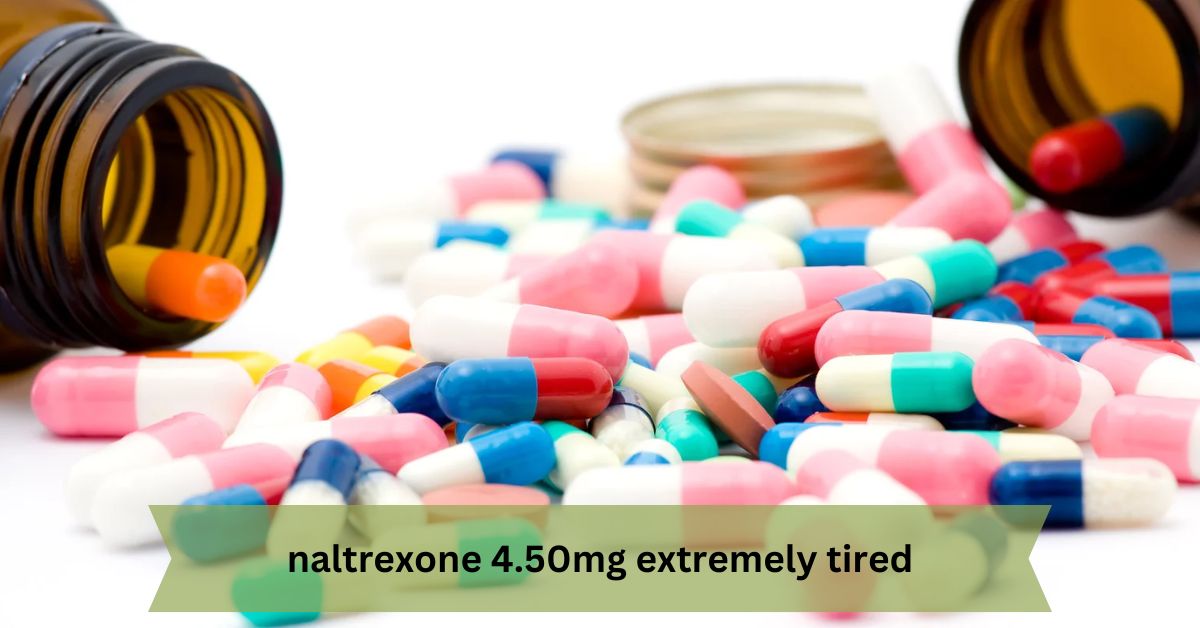Introduction
Naltrexone, a medication commonly used to treat opioid and alcohol dependence, has gained attention for its use in low doses (4.50mg) for various off-label purposes. While many users have reported positive effects, one of the significant side effects is extreme tiredness.
What is Naltrexone 4.50mg?
Naltrexone is an opioid receptor antagonist, meaning it blocks the effects of opioids in the brain. At higher doses, it’s prescribed to help individuals overcome addiction to opioids or alcohol.
However, at low doses, such as 4.50mg, it has been used off-label for conditions like autoimmune disorders, chronic pain, and fibromyalgia.
The low-dose form, often referred to as Low Dose Naltrexone (LDN), is believed to modulate the immune system and reduce inflammation.
How Does Naltrexone Work?
In its low-dose form, naltrexone temporarily blocks opioid receptors in the brain, which may trigger the release of endorphins and enhance the body’s natural pain-relief mechanisms. This is why it is often prescribed for conditions involving chronic pain and inflammation.
Why Does Naltrexone 4.50mg Cause Extreme Tiredness?
While naltrexone has shown promise in treating various conditions, one of the most commonly reported side effects at the 4.50mg dose is extreme tiredness. Understanding the reasons behind this fatigue can help users better manage it.
1. Disruption of Endorphin Production
Naltrexone works by blocking opioid receptors, which can temporarily reduce the body’s natural production of endorphins—chemicals in the brain that help relieve pain and promote feelings of well-being. This reduction can lead to feelings of fatigue as the body adjusts to the medication.
2. Changes in Sleep Patterns
Some users report that naltrexone disrupts their sleep, especially when taken during the day. This disruption can lead to poor-quality sleep, which in turn causes tiredness during waking hours.
3. Individual Variability
Every individual’s response to medication is different. Some people may metabolize naltrexone more slowly, leading to prolonged effects and increased fatigue. Others may be more sensitive to changes in their neurochemistry, making them more prone to tiredness.
4. Adjustment Period
When starting naltrexone 4.50mg, the body may need time to adjust to the medication. During this adjustment period, extreme tiredness is common. This side effect often diminishes after a few weeks as the body adapts.
Managing Extreme Tiredness on Naltrexone 4.50mg
If you’re experiencing extreme tiredness while taking naltrexone 4.50mg, there are several strategies you can employ to manage this side effect.
1. Timing of Dosing
Taking naltrexone at a specific time of day can help manage tiredness. For some individuals, taking the medication in the evening or before bed can reduce the impact of fatigue during the day.
This allows the body to process the medication overnight, potentially leading to a more restful sleep and reduced tiredness during waking hours.
2. Gradual Dose Adjustment
If extreme tiredness persists, consider discussing with your healthcare provider the possibility of starting with a lower dose and gradually increasing to 4.50mg. This gradual approach can help the body adjust more slowly and minimize side effects.
3. Incorporating Energy-Boosting Activities
Engaging in light exercise, spending time outdoors, or practicing mindfulness techniques can help combat fatigue. These activities can boost energy levels and improve overall well-being.
4. Monitoring Diet and Hydration
A balanced diet and proper hydration are essential when managing medication side effects. Certain foods, like those high in protein and complex carbohydrates, can provide sustained energy throughout the day. Staying hydrated also helps maintain energy levels and prevents fatigue.
5. Ensuring Quality Sleep
Prioritizing good sleep hygiene is crucial when dealing with tiredness. Create a calming bedtime routine, avoid caffeine and screen time before bed, and ensure your sleeping environment is comfortable. These practices can help improve sleep quality and reduce daytime fatigue.
Naltrexone 4.50mg: Success Stories and User Experiences
Many individuals who take naltrexone 4.50mg report positive outcomes despite initial challenges with fatigue. Understanding these success stories can provide hope and encouragement for those struggling with tiredness.
Case Study 1: Overcoming Chronic Fatigue Syndrome
A 45-year-old woman diagnosed with Chronic Fatigue Syndrome (CFS) started naltrexone 4.50mg as part of her treatment plan. Initially, she experienced extreme tiredness, which made it difficult to maintain her daily routine.
However, after adjusting her dosing schedule to take the medication at night, her energy levels gradually improved. Over time, she noticed a significant reduction in her CFS symptoms and was able to return to a more active lifestyle.
Case Study 2: Managing Fibromyalgia-Related Fatigue
A 52-year-old man with fibromyalgia began taking naltrexone 4.50mg to manage his chronic pain. While he initially struggled with severe fatigue, he found that incorporating a daily walk and adjusting his diet helped boost his energy. After several weeks, his body adapted to the medication, and the fatigue lessened. He reported that the benefits of pain reduction far outweighed the initial tiredness he experienced.
FAQs
1. How long does it take for tiredness to subside when starting naltrexone 4.50mg?
For most individuals, tiredness begins to subside after a few weeks as the body adjusts to the medication. However, the timeline can vary depending on individual factors such as metabolism, overall health, and sensitivity to the drug.
2. Can I take naltrexone 4.50mg in the morning if it makes me tired?
While some people may be able to take naltrexone in the morning without experiencing fatigue, others find that taking it in the evening or before bed reduces tiredness during the day. It’s essential to find a dosing schedule that works best for your body.
3. Is extreme tiredness a sign that naltrexone 4.50mg isn’t working for me?
Not necessarily. Extreme tiredness is a common side effect when starting naltrexone 4.50mg. It often subsides as your body adjusts to the medication. However, if tiredness persists or worsens, consult your healthcare provider to discuss potential adjustments to your treatment plan.
4. Can lifestyle changes help reduce tiredness while taking naltrexone 4.50mg?
Yes, incorporating light exercise, maintaining a balanced diet, staying hydrated, and prioritizing good sleep hygiene can all help reduce tiredness. These lifestyle changes can support your overall health and enhance the benefits of the medication.
Conclusion
Naltrexone 4.50mg can be a powerful tool for managing various health conditions, but it’s not without its challenges. Extreme tiredness is a common side effect that can be managed with the right strategies and support.



